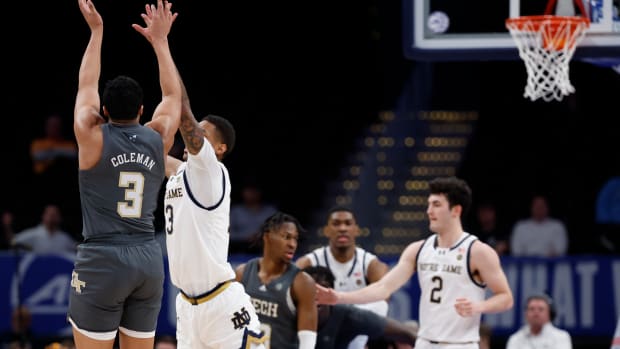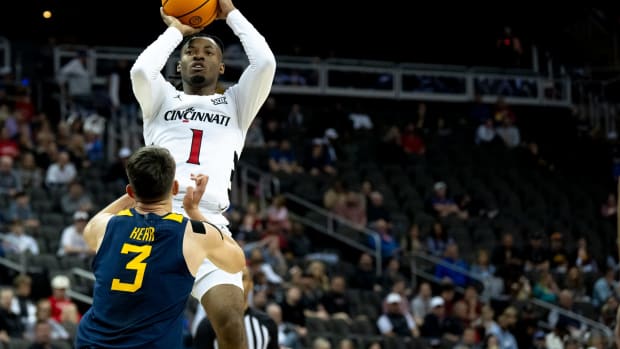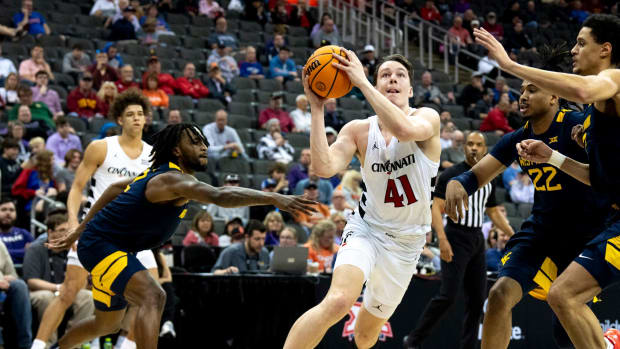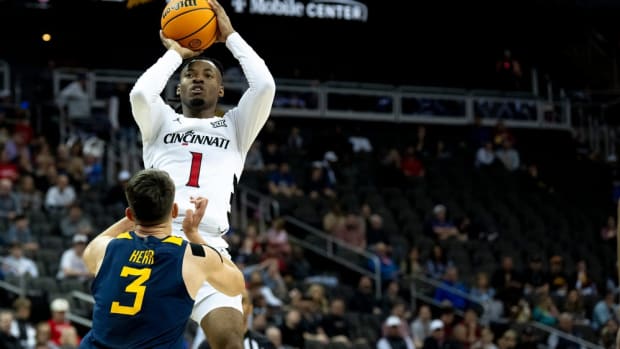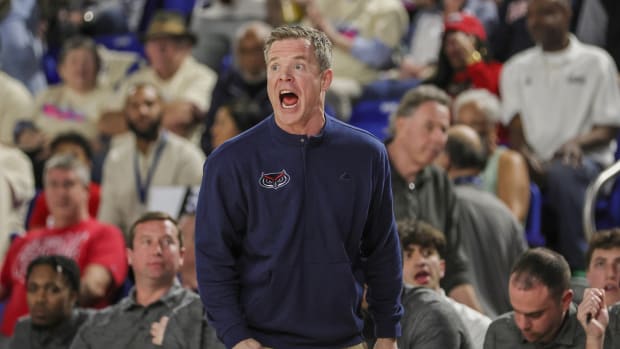Even with UConn’s dominance, parity in women’s game keeps growing
Get all of Lindsay Schnell’s columns as soon as they’re published. Download the new Sports Illustrated app (iOS or Android) and personalize your experience by following your favorite teams and SI writers.
INDIANAPOLIS — Before he cut down the nets, before he wrapped maybe the greatest women’s player of all time in a hug, before his seniors walked off the floor with the best four-year record of all time, Connecticut coach Geno Auriemma was asked what a first-ever Final Four run can mean to a program.
“It's what you do after you get home,” he said. “What happens next year, the year after, the year after and the year after? Is this a one-time deal, or is this the beginning of something that’s going to last a long time?”
Nobody has the answer to that right now, Auriemma pointed out. More will be determined in the next five seasons than was determined Tuesday night, when UConn ran away from Syracuse for an 82–51 win in the women’s title game, giving Auriemma’s Huskies their 11th NCAA championship.
UConn women rout Syracuse to win fourth consecutive national title
UConn’s dominance is unprecedented and undeniable. But is it unbreakable?
After UConn beat Texas to advance to Indianapolis, Auriemma spoke at length about growing parity in the women’s game, evidenced by three first-time Final Four participants in Oregon State, Syracuse and Washington, none of which were No. 1 seeds.
“Maybe it’s been a long time coming, and maybe it’s taken a little longer than some people would have wanted, but I remember in 1991, when we went to the Final Four and we were the first team from north of the Mason Dixon line to ever play in the Final Four, and it was like we had somehow landed on the moon and what were we doing there?” Auriemma said.
“I think this is a great message to everybody: Stop focusing on what Connecticut does and start paying attention to what a lot of these other schools are doing.”
Mike Neighbors agrees. The third-year Washington head coach had to prep his team for the national semifinal against Syracuse on Sunday night, which Washington would lose 80–59, but because he was already in town, made sure to swing by the coaches’ convention, too. Early Sunday he spoke on a panel of other former assistants who had transitioned to head coaches, passing on advice to aspiring head coaches. His parting line: “Y’all better be looking at the sideline tonight and thinking, ‘If Mike and [Oregon State’s] Scott [Rueck] and [Syracuse’s] Quentin [Hillsman] can get their teams to the Final Four, we can go, too.’”
Neighbors’s argument for that: Teams No. 2 through 40 are really, really good. It just so happens that for the last four years, team No. 1 has been great. In a weird way, he said that makes this year more special. When he retires, he’ll consider this trip to Indianapolis “a great point of pride in my career, because we did it when it was the hardest, when UConn was so good.”
Perfection: UConn’s Stewart leaves legacy as unparalleled winner
It’s not going to be like this forever though. Many expect next season to be one of the best, and most wide open, in women’s basketball’s recent history. Connecticut’s big three of Breanna Stewart, Moriah Jefferson and Morgan Tuck will leave (Tuck is a redshirt junior but many expect her to go), while other top programs return big-time talent. Baylor, Notre Dame, South Carolina, Texas, Stanford and Syracuse should all be capable of deep postseason runs. Maryland brings in the nation’s top-ranked recruiting class. Ohio State returns one of the nation’s elite scorers in Kelsey Mitchell, and a couple key transfers become eligible. Though UConn rolled through the tournament, winning its six games with a 37-point average margin of victory, this Final Four could be looked back on as the start of a new era.
“It’s unique, with three first-timers along with UConn,” said Baylor coach Kim Mulkey. “It probably gives a lot of teams hope.”
Not so long ago, Mulkey coached one of those teams. In 2000, the former Louisiana Tech standout inherited a program wallowing in mediocrity. Five years later, she led the Bears to their first Final Four and the 2005 national title.
“It’s hard to build, but it’s even harder to maintain,” Mulkey said by phone late Tuesday from LSU, where she was watching her son Kramer play baseball for the Tigers. “When we won in ’05, there was no blueprint for it. We just had to feed that monster.”
Like always, it started with recruiting. Mulkey says the 2005 trophy opened doors to recruiting the Bears had never been able to walk through. Now they’re the first to knock and be invited in, annually signing some of the best classes in the country. They’re a perennial national championship contender. Many thought Baylor had the best chance to knock off UConn this season, but the Bears lost in the Elite Eight to Oregon State and didn’t get a shot to try.
“The game is growing, whether people want to say it is or not,” Mulkey said. “Television exposure is up, we’ve got new teams in the Final Four, big resources are being put into women’s basketball. Kids who are playing take notice of that.”
Philadelphia Threedom: How Villanova became the national champion
Here’s what outsiders need to understand about how quickly parity can expand, which Mulkey and Auriemma touched on this week: The women’s game is incomparable to the men’s not because of a lack of dunking or lower shooting percentages, but because of what comes after. Top female recruits will likely never be tempted to go to unheralded schools or mid-major program with the hopes of getting their draft stock up, because the one-and-done concept doesn’t exist for women. And that’s O.K.
Change, as the old saying goes, takes time. There are hints that it could be different soon. We’ve already seen top players who want to go somewhere besides UConn to see if they can challenge, and ultimately beat, the Huskies. Neighbors believes the attention needs to be on that, instead of the tired argument that UConn had no serious competitors this season. (Stewart might be the best women’s college player of all time. She’s supposed to win a lot.) Washington star and former McDonald’s All-American Kelsey Plum is a perfect example. For decades, west coast talent felt like it had to go back east to compete for national championships. Plum, a Poway, Calif., native, stayed home, picking Washington when a Final Four run seemed unreachable.
“Let’s celebrate stories like Kelsey, and like Oregon State and the incredible rebuild Scott’s done,” Neighbors said. “We’re just not focused on the right things. It’s like in recruiting, when you see a kid too much: You start to pick apart her game and question what she can’t do instead of appreciating everything she’s doing right, and well. Our game is in really good shape if you know what you’re looking at.”
Two Shining Moments: Jenkins one-ups Paige in alltime classic
After his team’s season ended in predictable heartbreak, Syracuse coach Hillsman congratulated Stewart, the Syracuse native who finished with 24 points, 10 rebounds and six assists and won her fourth Most Outstanding Player honor. “I remember she came to my camp in the ninth grade, I watched her grow up,” he said. “We talk about a kid being that good from Syracuse, it really doesn’t happen very often.”
Syracuse was a non-factor when Stewart came out of high school, and the Orange didn’t have a shot at signing her. When asked about the next kid coming out of that area who’s that good, and if the Orange’s success this season could persuade her to stay home, Hillsman didn’t hesitate. “The next one who comes, we’re getting her,” he said, adding that the next one will do what Stewart has done: make the game great. “We won’t lose another one. Don’t worry about that.”
Hillsman understands the program’s first Final Four can be instrumental in landing that player. More importantly, he knows, just like Auriemma before him, that it needs to be.

